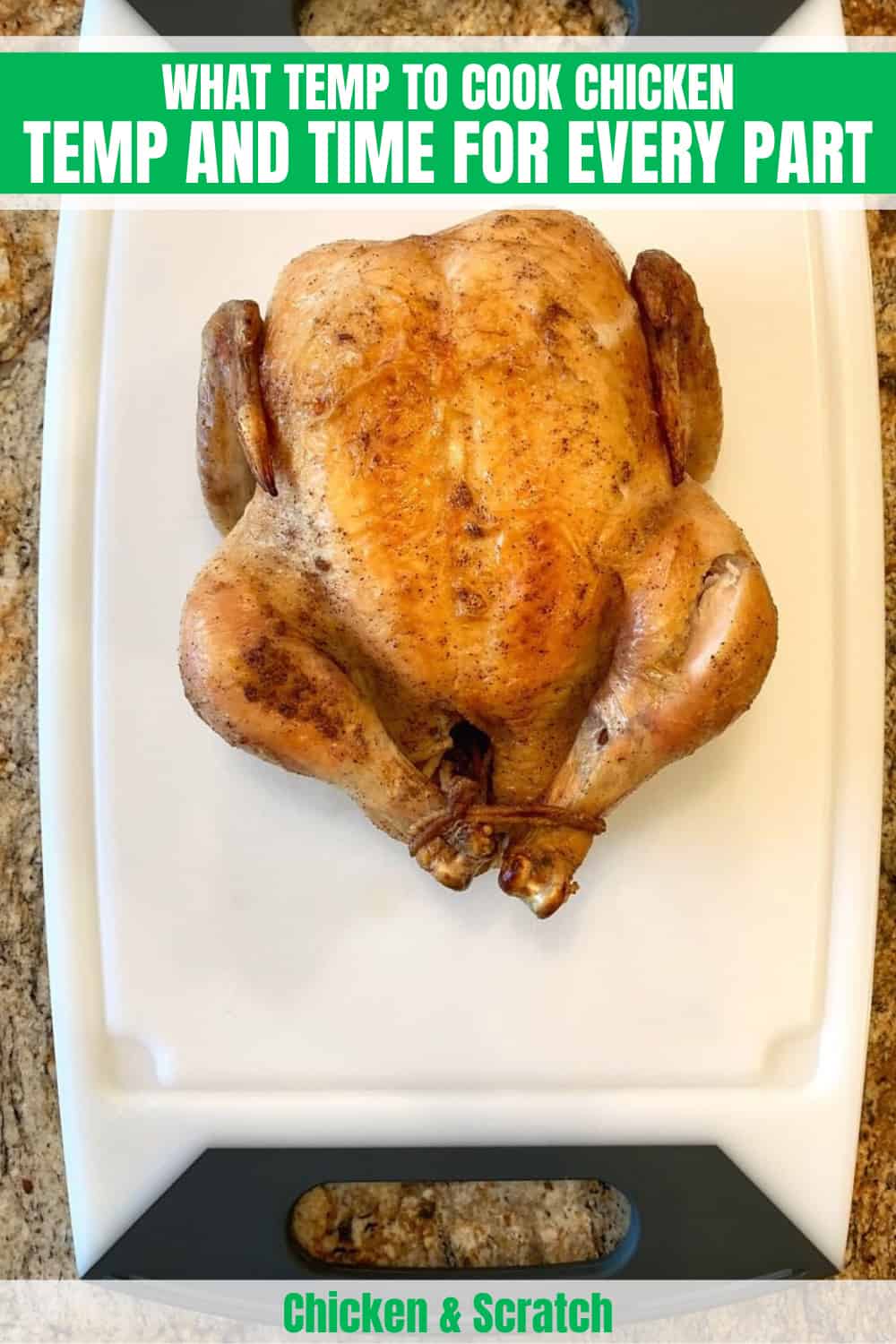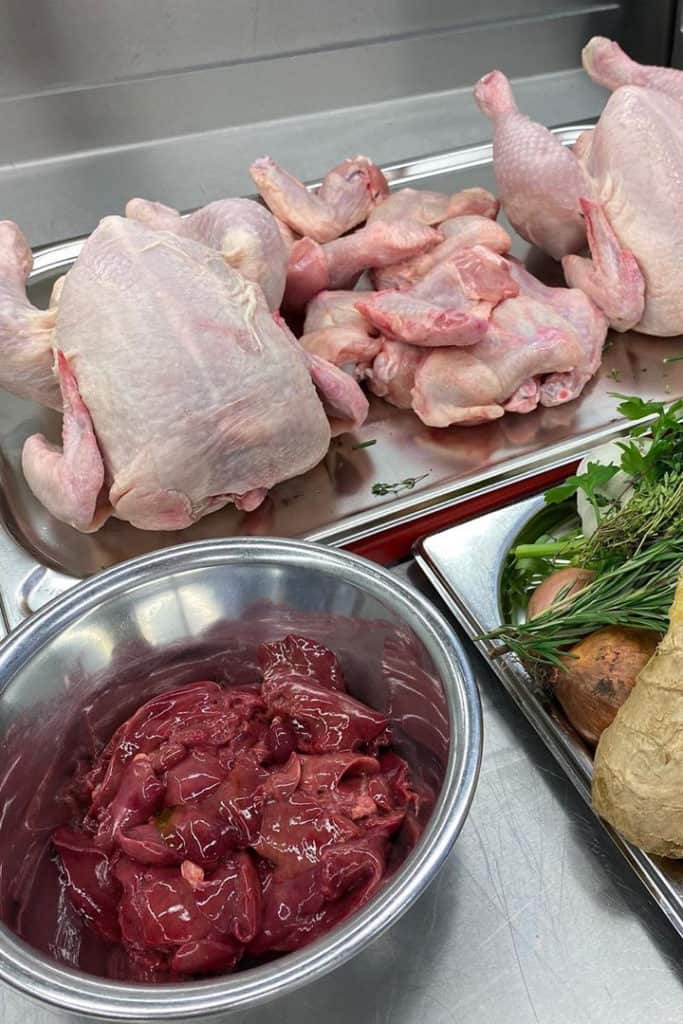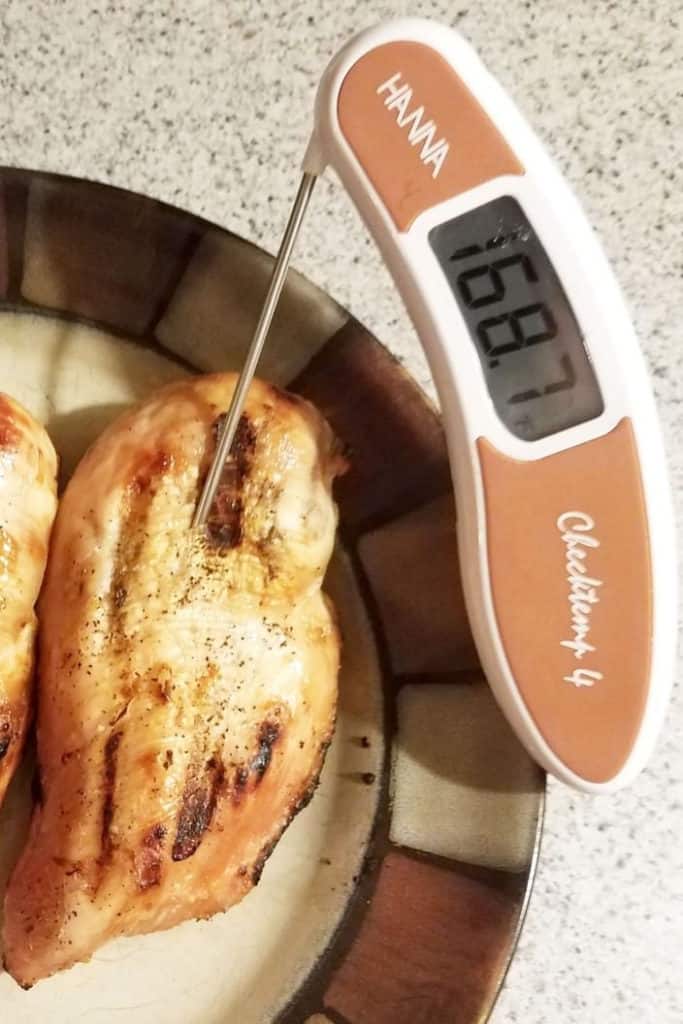The most efficient and safest way to cook chicken is to use a meat thermometer to check the internal temperature. But the real key question is what temp to cook chicken. The answer is to ensure that all parts of the chicken, including breasts, thighs, wings, legs, and ground chicken, reach an internal temperature of 165 degrees Fahrenheit, although they may not all reach this temperature simultaneously.

Cooking Chicken to the Correct Internal Temperature is Critical
Cooking chicken to perfection is not as commonly achieved as most would like. It can come out overcooked, making it dry and stringy. It may be undercooked and troublesome. Or, in the case of the typically catered event, rubber chicken.
The USDA’s Food Safety and Inspection Service (FSIS) suggest to cook chicken at 165 degrees. It includes a whole chicken, chicken parts, ground poultry, and stuffing.
The primary reason for ensuring the meat reaches 165 degrees is to safeguard against the health risks associated with bacteria that chicken can harbor.
Poultry can harbor bacteria such as Salmonella and Campylobacter, which can cause food poisoning. By checking the internal temperature of the meat, you can be sure you have overcome these health risks.
You safeguard all who will enjoy your chicken when you ensure these bacteria cook under the temperature that destroys them.
The benefit of learning the correct temperature to cook the chicken is that it helps achieve the tender juiciness that makes your chicken a hit every time. It includes learning how important it is to let the meat rest before cutting it. Following this sound cooking tip helps avoid ending up with dry chicken.
Chicken Temperature Chart
| Chicken Part | Cooking Method | Cooking Time |
|---|---|---|
| Bone-in Breast | Roasting (350°F) | 50-60 minutes |
| Bone-in Breast | Simmering | 35-40 minutes |
| Bone-in Breast | Grilling | 45-50 minutes |
| Boneless Breast | Roasting (350°F) | 30 minutes |
| Boneless Breast | Simmering | 25-30 minutes |
| Boneless Breast | Grilling | 6-8 minutes |
| Thighs | Roasting (350°F) | 40-50 minutes |
| Thighs | Simmering | 40-50 minutes |
| Thighs | Grilling | 10-15 minutes |
| Drumsticks | Roasting (350°F) | 35-45 minutes |
| Drumsticks | Simmering | 40-50 minutes |
| Drumsticks | Grilling | 8-12 minutes |
| Wings | Roasting (350°F) | 30-40 minutes |
| Wings | Simmering | 35-45 minutes |
| Wings | Grilling | 8-12 minutes |
As meat cooks, the heat affects its juices. These juices can get reabsorbed if the meat is allowed to rest before serving. Do you notice how much of the juices escape when you directly cut the meat rather than waiting?
Generally, you can allow the chicken to rest between 10-20 minutes before serving. The larger the cut, the more time should be allowed for rest. For example, chicken breast parts only need to rest around 5-10 minutes, whereas a whole bird should rest for up to 20 minutes.
You can let the chicken rest uncovered. Also, you may cover it using tented aluminum foil to help keep it warm. But avoid wrapping too tightly, as it can lead to moisture sweating out rather than allowing it to reabsorb.
After resting, you will find the juices within the meat upon slicing. Your chicken will be more flavorful and tender.
It is worthwhile for the primary meal and also for leftovers when reheating. You might also use a touch of chicken broth or stock in reheating to fortify flavor and moisture.
How Long Does It Take To Cook Chicken?

here are general rules for how long it typically takes to cook a roast chicken. You can figure between 20 to 30 minutes per pound when cooked at 375 degrees for unstuffed birds.
On average, the size of the bird you might pick up at the grocer may vary. But a standard size is about four pounds. In terms of time, this amounts to between 1 ½ to 2 hours of cooking.
For a breakdown of the different forms, here is a simple rundown:
Bone-in breast halves weigh between 6-8oz.
- Roasted in the convection oven at 350 degrees takes 50-60 minutes
- Simmered on the stove takes 35-40 minutes
- Cooked on the grill takes 45-50 minutes
Boneless breast halves weigh approximately 4oz.
- Roasted in the oven at 350 degrees takes 30 minutes
- Simmered on the stove takes 25-30 minutes
- Cooked on the grill takes 6-8 minutes
Thighs weigh from 4-8oz.
- Roasted in the oven at 350 degrees takes 40-50 minutes
- Simmered on the stove takes 40-50 minutes
- Cooked on the grill takes 10-15 minutes
Drumsticks typically weigh 4oz.
- Roasted in the oven at 350 degrees takes 35-45 minutes
- Simmered on the stove takes 40-50 minutes
- Cooked on the grill takes 8-12 minutes
Wings vary in weight from 2-3oz.
- Roasted in the oven at 350 degrees takes 30-40 minutes
- Simmered on the stove takes 35-45 minutes
- Cooked on the grill takes 8-12 minutes
These times are simply guidelines. Different recipes may call for varying cooking times and temperatures. And over time, you might discover a preferred method that suits your cooking style.
When you use a meat thermometer, you start to recognize the timing it takes for different cuts. But what matters is when and where you take the temperature.
How To Check The Temperature of Chicken With A Meat Thermometer

There are quite a few thermometers available on the market. When checking your chicken, you only need one that will give you an immediate reading. You can choose either a dial thermometer or a digital pocket thermometer. Both types will serve you well and are generally inexpensive.
If you do not already have one, an oven thermometer that you can leave on the shelf helps to verify your oven temperature matches the readout on the panel. If it is off, you want to get it calibrated, as this affects the temperature of your chicken.
When checking the chicken’s temperature, insert the thermometer into its thickest part.
You want to avoid touching bone or other pieces with more fat or gristle. Why so? The reading will not be accurate for the meat if you place it incorrectly.
You typically check the temperature near the end of cooking time before it is done.
Whichever cooking method you use, you can check the temperature of the meat to be sure it has reached at least 165 degrees. Dark meat, like the legs and thighs, takes a little longer to come to temp because of its fat content. Conversely, boneless cuts take less time than bone-in parts.
You can reheat the leftover chicken. But you still want to check the temperature to ensure it reaches an internal temperature of 165. Always avoid reheating leftovers more than once, as this can lead to loss of flavor and potential health risks.
Frequently Asked Questions
1. Is it preferable to bake chicken at 350°F or 400°F?
Many prefer cooking the chicken at 400 degrees because it gives a crispier skin. Also, it is ideal for chicken breast, leaving it tender, juicy, and full of flavor. But this also differs in the time in parallel with the heat.
To give you basic guidelines, here’s what you need to follow:
- For 400 degrees: it may take around 22 to 26 minutes. The bigger the part, the longer the baking time. But if you plan to wrap it in foil, you need to bake it for 30 minutes.
- For 350 degrees: it takes longer about 25 to 30 minutes.

2. How long does chicken need to be at 165°F to be safe?
Based on USDA, at least 30 seconds is ideal. It is the standard measure to ensure all harmful bacteria are removed. They also note that consumers can choose a higher temperature. But, in cases of poultry, this may cause an unpleasant texture. So better to use a meat thermometer to achieve a well-cooked meal.
3. Why is my chicken dry at 165°F?
There are two reasons for that. One is poking the meat thermometer in the wrong places. And two, you’ve exceeded the recommended cooking time.
If you stick the probe near the bone, you can expect a colder temperature. Imagine waiting for it to reach 165°F only to find out the red meat is past the suggested internal temp. Lastly, pull out the chicken after reaching the desired temp. The meat will continue to cook because it can retain heat for a while.
Summary
Chicken is one of the meats you need to take special care to avoid undercooking. Knowing what temp to cook chicken is a sure way to prevent illness.
With time, cooks become familiar with the different times needed to cook the respective chicken parts. When you are sure of your times and temps, your chicken will be cooked to perfection every time.

Joseph Hudson has been raising chickens for over 15 years. In 2018, he completed the Agriculture & Natural Resources program at Mt. San Antonio College. He currently raises over 1400 chickens on his 7.5-hectare farm. He keeps sharing his experience on raising healthy and happy chickens on Chicken Scratch The Foundry.






